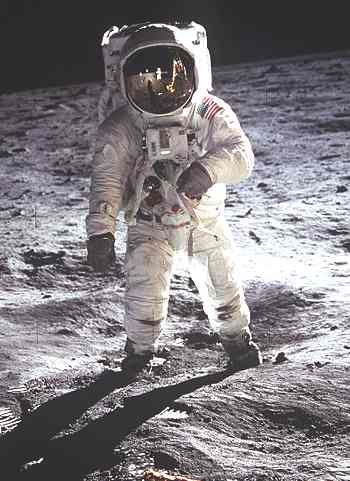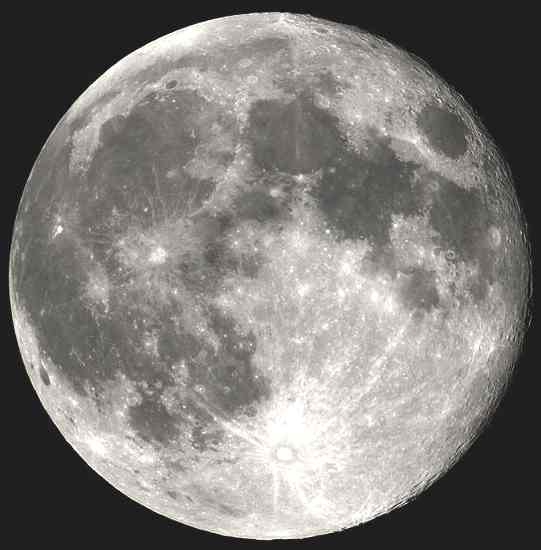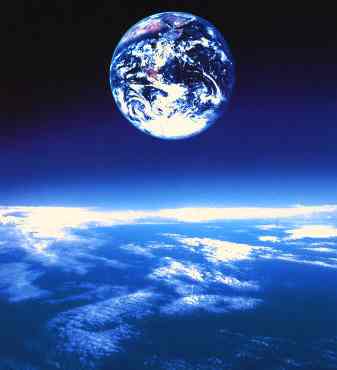|
THE MOON
|
|
|
HOME | BIOLOGY | FILMS | GEOGRAPHY | HISTORY | INDEX | INVESTORS | MUSIC | NEWS | SOLAR BOATS | SPORT |
|
|
The Moon (Latin: Luna) is Earth's only natural satellite, and the fifth largest moon in the Solar System. The average centre-to-centre distance from the Earth to the Moon is 384,403 kilometres (238,857 mi), which is about 30 times the diameter of the Earth. The Moon has a diameter of 3,474 kilometres (2,159 mi) - slightly more than a quarter that of the Earth. This means that the volume of the Moon is close to 1/50th that of Earth. The gravitational pull at its surface is about 1/6th of Earth's. The Moon makes a complete orbit around the Earth every 27.3 days, and the periodic variations in the geometry of the Earth–Moon–Sun system are responsible for the lunar phases that repeat every 29.5 days.
Man on the Moon - Buzz Aldrin, Apollo landing
The Moon is the only celestial body to which humans have travelled and upon which humans have landed. The first artificial object to escape Earth's gravity and pass near the Moon was the Soviet Union's Luna 1, the first artificial object to impact the lunar surface was Luna 2, and the first photographs of the normally occluded far side of the Moon were made by Luna 3, all in 1959. The first spacecraft to perform a successful lunar soft landing was Luna 9, and the first unmanned vehicle to orbit the Moon was Luna 10, both in 1966. The United States (U.S.) Apollo program achieved the only manned missions to date, resulting in six landings between 1969 and 1972. Human exploration of the Moon ceased with the conclusion of the Apollo program, although, as of 2007, several countries have announced plans to send either people or robotic spacecraft to the Moon.
Name and etymology
Unlike the moons of other planets, the moon of the Earth has no proper English name other than "the Moon" (capitalized).
The word moon is a Germanic word, related to Latin mensis; it is ultimately a derivative of the Proto-Indo-European root me-, also represented in measure (time), with reminders of its importance in measuring time in words derived from it like Monday, month and menstrual. In English, the word moon exclusively meant "the Moon" until 1665, when it was extended to refer to the recently-discovered natural satellites of other planets. The Moon is occasionally referred to by its Latin name, Luna, in order to distinguish it from other natural satellites, with a related adjective lunar, and an adjectival prefix seleno- or suffix -selene (from the Greek deity Selene).
Ocean tides
Earth’s ocean tides are initiated by the tidal force of Moon’s gravity and are magnified by a host of effects in Earth’s oceans. The gravitational tidal force arises because the side of Earth facing the Moon (nearest it) is attracted more strongly by the Moon’s gravity than is the center of the Earth and—even less so—the Earth’s far side. The gravitational tide stretches the Earth’s oceans into an ellipse—with the Earth in the center. The effect takes the form of two bulges—elevated sea level—relative to the Earth: one nearest the Moon and one farthest from it. Since these two bulges rotate around the Earth once a day as it spins on its axis, ocean water is continuously rushing towards the ever-moving bulges. The effects of the two bulges and the massive ocean currents chasing them are magnified by an interplay of other effects; namely frictional coupling of water to Earth’s rotation through the ocean floors, inertia of water’s movement, ocean basins that get shallower near land, and oscillations between different ocean basins. The magnifying effect is a bit like water sloshing high up the sloped end of a bathtub after a relatively small disturbance of one’s body in the deep part of the tub.
Gravitational coupling of the Moon to the tidal bulges of Earth’s oceans, which slightly lag in phase and don’t point precisely towards the Moon, drains kinetic energy from the Moon’s orbital motion around the Earth. This results in a 3.8 cm yearly increase in the distance between the two bodies. The Moon will continue to move slowly away from the Earth until the tidal effects between the two are no longer of significance, whereupon the Moon's orbit will stabilise.
The Moon landing
Lunar surface
Two sides of the Moon
The Moon is in synchronous rotation, meaning that it keeps nearly the same face turned towards the Earth at all times. Early in the Moon's history, its rotation slowed and became locked in this configuration as a result of frictional effects associated with tidal deformations caused by the Earth.
Long ago when the Moon spun much faster, the Moon's tidal bulge preceded the Earth-Moon line because the Moon couldn't "snap back" its bulges quickly enough to keep its bulges in line with Earth. The rotation swept the bulge beyond the Earth-Moon line. This out-of-line bulge caused a torque, slowing the Moon spin, like a wrench tightening a nut. When the Moon's spin slowed enough to match its orbital rate, then the bulge always faced Earth, the bulge was in line with Earth, and the torque disappeared. That's why the Moon rotates at the same rate as it orbits and we always see the same side of the Moon.
Actually we see a little more than half a moon. Small variations resulting from the eccentricity of the lunar orbit, termed librations, allow about 59% of the lunar surface to be viewed from Earth.
The side of the Moon that faces Earth is called the near side, and the opposite side the far side. The far side should not be confused with the dark side, which is the hemisphere that is not being illuminated by the Sun at a given moment (this may be the side facing the Earth, as it is once a month during the New Moon phase). The far side of the Moon was first photographed by the Soviet probe Luna 3 in 1959. One distinguishing feature of the far side is its almost complete lack of maria.
Earth's Satellite
Earth has only one natural satellite, the Moon. But
Distance Radius Mass
Satellite (000 km) (km) (kg)
--------- -------- ------ -------
Moon 384 1738 7.35e22
LINKS and REFERENCE
Healthier alternative tastes for adventure capitalists
|
|
|
This
website
is Copyright © 1999 & 2012 NJK. The bird |
|
|
AUTOMOTIVE | BLUEPLANET | ELECTRIC CARS | ELECTRIC CYCLES | SOLAR CARS |



